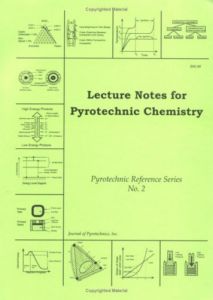Explosives, Fireworks, Science / Chemistry / Analytic, Technology & Engineering / Fire Science
Course Outline:Basic Chemical PrinciplesPyrotechnic Chemistry, Ignition and PropagationPyrotechnic Primes and PrimingFactors Affecting Burn RateAspects of Pyrotechnic BurningPhysical Basis for Colored Light ProductionChemistry of Colored FlameChemistry of Sparks, Glitter and StrobePyrotechnic Smoke and NoiseApproaches to Formulation DevelopmentPyrotechnic SensitivenessPyrotechnic Hazard Management
The recent output of books providing accurate scientific discourse on pyrotechnics has been almost nonexistent. While there are still copies of many good texts on this subject, new editions to this extant literature have been rare. The publication of the two-part syllabus of the course "Lecture Notes for Pyrotechnic Chemistry" is a welcome addition to the chemistry of pyrotechnics literature. (Note that earlier edi-tions were called: "Chemistry of Fireworks" and "Chemistry of Pyrotechnics".) The layout of this publication exists somewhere between a course outline and a book and has many strong points.
Many great traditional pyrotechnic texts do not discuss or just briefly mention the topics of whistles and strobes. Their discussion in this publication is very strong and up to date. I especially found the description of their proposed burn mechanisms helpful. The text covers the fundamental principles necessary for a basic understanding of pyrotechnic chemistry. Readers with both a chemistry and non-chemistry background will find this text a valuable addition to their collection of pyrotechnic literature.
Hazard management, in the last section of the text, has good charts highlighting hazardous chemical combinations. This strong section could only be strengthened by providing information about proper disposal of residue and waste chemicals.
Because of the outline nature of the text, such things as references for some of the sources, page numbers, and an index did not appear in the earlier editions. However, edition 3.1 includes page numbers and a nine page index.
Discussion of major topics was well done, although I would like to see more on the effects of hygroscopicity. The presentation of oxidation states is very brief, and I would like to see this dealt with in more detail. Those without training in chemistry often find oxidation and reduction reactions a difficult subject.
This volume should be of real benefit to all those involved in pyrotechnics and a welcome new addition to my pyrotechnics library.
This review originally appeared in "Journal of Pyrotechnics", No. 6, Winter, 1997 and was for an earlier edition. The book has recently been revised and expanded, but is still available at the same price.
